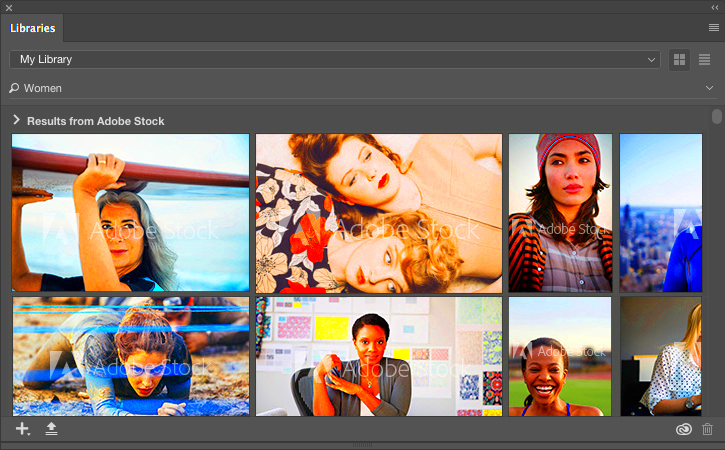Adobe Stock offers a vast collection of top notch images, videos and creative resources that can take your projects to the next level. When I initially explored
Adobe Stock I was taken aback by the abundance of content on offer. However as I dug deeper I discovered that this platform has the potential to revolutionize the way professionals source visuals. Its not merely a matter of locating images; it provides an entry, into a realm of artistry and originality.
Adobe Stock seamlessly integrates with Adobe Creative Cloud allowing you to work directly in applications such as Photoshop and Illustrator. This integration smooths out your workflow making it easier to access and use assets without interrupting your creative process.The platform provides various subscription options and credit bundles to cater to different preferences and financial plans. Whether you're an independent professional facing a time constraint or a sizable agency with varied needs there's a suitable plan available. Grasping these choices is crucial for maximizing the benefits of your subscription or credit bundle.If youre a newcomer to
Adobe Stock taking the time to explore its features and benefits can greatly enhance your efficiency. Personally I discovered that getting the hang of the platform not only boosted my productivity but also sparked my creativity.
Getting Started with Adobe Stock

Getting started with
Adobe Stock is akin to unlocking a realm of limitless opportunities. To begin you need to establish an Adobe account if you haven’t done so already. Once you're all set up you can conveniently access
Adobe Stock either through Adobe Creative Cloud or by visiting the
Here's a simple guide to getting started:- Create an Adobe Account: Sign up on the Adobe website. If you already use Adobe products, you can use your existing account.
- Choose a Plan: Select a subscription plan or credit pack that suits your needs. Adobe Stock offers various options, from monthly plans to on-demand credits.
- Explore the Library: Start by browsing through the vast library of images, videos, and templates. You can use filters to narrow down your search based on categories, color, or orientation.
- Download and Use Assets: Once you find the right asset, you can easily download it in high resolution. The integration with Adobe Creative Cloud ensures a smooth process.
When I first started out I felt overwhelmed by the options available to me. However as I took the time to explore the platform and try out its various features the journey became much more seamless. It's similar to mastering a recipe; once you grasp the steps it becomes instinctive.
Finding the Right Images on Adobe Stock

Searching for the perfect picture on
Adobe Stock can be a bit challenging with so many choices to choose from. However with some helpful strategies you can make your search more efficient and discover exactly what you're looking for.
Here are some strategies to help you:- Use Specific Keywords: When searching, use detailed and specific keywords to narrow down your results. For example, instead of searching for "business," try "young professional working on laptop."
- Apply Filters: Utilize filters to refine your search. You can filter by image type (photo, illustration, vector), orientation, color, and even contributor.
- Check Similar Images: Adobe Stock offers a “similar images” feature. If you find an image you like but need something slightly different, this feature can help you find related visuals.
- Explore Collections: Adobe Stock often curates collections based on themes or trends. Browsing these collections can provide inspiration and help you discover images that fit your project.
Based on what I’ve seen the search function can be overwhelming initially. However experimenting with various keywords and filters proves to be quite beneficial. I recall an instance where I spent a lot of time searching for the image for a clients project. Once I became familiar with the search features locating visuals became significantly faster and more streamlined.
Downloading Images from Adobe Stock
Downloading images from Adobe Stock is a smooth process but here are some suggestions to maximize your experience. I recall the moment I required images for a clients project. I felt a bit unsure about the best approach. However through time and some trial and error I discovered that familiarizing myself with the download choices and organizing files effectively had a significant impact.
Here are some tips for optimizing your downloads.- Choose the Right License: Adobe Stock offers different types of licenses – Standard and Extended. Make sure to select the one that fits your project’s needs. Standard licenses are great for most uses, but Extended licenses cover additional rights, which can be useful for commercial projects.
- Download in the Right Resolution: When you find an image, choose the resolution that suits your needs. For print projects, opt for high-resolution images, while web projects might only require lower resolutions.
- Organize Your Downloads: Create a folder system on your computer to keep your downloaded images organized. This way, you’ll easily find what you need without sifting through countless files.
- Check File Formats: Adobe Stock provides images in various formats. Make sure to download the format that is compatible with your design software to avoid any issues during editing.
There was an occasion when I mistakenly downloaded the resolution for a print advertisement causing a rushed situation. Since that incident I’ve made it a point to thoroughly review my choices. It’s an adjustment but it significantly helps me avoid unnecessary stress.
Managing Your Adobe Stock Library
Keeping your Adobe Stock library organized can really help you save time and avoid stress. I used to have a hard time keeping tabs on all my assets and would often find myself rummaging through a jumbled mess of files. However once I started using a methodical strategy everything became a lot smoother.
Here are a few tips to help you maintain your librarys organization.- Create Folders: Organize your assets into folders based on categories, projects, or clients. This will help you locate files quickly and keep related images together.
- Use Tags and Keywords: Tag your images with relevant keywords. Adobe Stock allows you to add tags, which makes searching for specific images much more efficient.
- Regularly Clean Up: Periodically review and delete any outdated or unused files. This will keep your library clutter-free and make it easier to find the assets you need.
- Backup Your Library: Consider backing up your library to an external drive or cloud storage. This way, you won’t lose your valuable assets if something happens to your computer.
One approach that proved to be beneficial for me involved establishing a straightforward tagging system. For example I categorized pictures according to their themes such as nature, business or events. This significantly streamlined the process of quickly accessing the content I required particularly, when facing time constraints.
Using Adobe Stock Credits Wisely
Adobe Stock credits offer a convenient option for acquiring assets yet being mindful in their management can maximize your returns. I recall my initial experience with credits; I struggled to monitor my usage and ensure I was getting the value for my money. By following some suggestions you can make the most of your credits and prevent unnecessary spending.
Here are some tips for making the most of your Adobe Stock credits.- Plan Your Purchases: Before buying assets, plan what you need. This helps in making bulk purchases when necessary, which can often be more cost-effective.
- Monitor Your Usage: Keep an eye on your credit balance and usage. Adobe Stock provides a dashboard where you can track how many credits you have left and how they have been used.
- Use Credits for High-Value Assets: Save your credits for high-quality images or videos that are essential for your projects. For less critical assets, consider using free or lower-cost options.
- Take Advantage of Credit Packs: If you have ongoing needs, consider purchasing credit packs. These often come with discounts and can be more economical in the long run.
There was a time when I purchased credits for every single image and it became quite expensive. Since that experience I’ve figured out to buy in bulk and strategize ahead of time. This not only helped me save some cash but also streamlined my workflow significantly.
Tips for Efficient Use of Adobe Stock
Leveraging Adobe Stock efficiently can significantly impact the speed and effectiveness of your project completion. Initially I was daunted by the extensive range of resources and functionalities available. Nevertheless over time I discovered practical strategies that greatly assisted me in optimizing my workflow and maximizing the potential of this incredible tool.
To make the most out of your Adobe Stock experience consider these suggestions- Set Clear Search Parameters: Before you start searching, have a clear idea of what you need. Use specific keywords and apply filters to narrow down your results. For example, instead of searching for “nature,” you could use “tropical forest” or “sunset over mountains.”
- Save Your Favorite Assets: Utilize the "Favorites" feature to save images or videos that you like. This makes it easy to revisit and use them later without having to search for them again.
- Leverage Adobe Stock Integration: Take full advantage of Adobe Stock’s integration with Adobe Creative Cloud. You can directly access and insert assets into your Adobe apps, saving you time and hassle.
- Regularly Review and Update: Keep your Adobe Stock library updated by regularly reviewing and removing outdated assets. This will help maintain an organized and relevant collection of visuals.
- Explore Contributor Collections: Check out collections curated by contributors. These often feature high-quality, themed content that can inspire and provide fresh options for your projects.
I have a suggestion for you. It’s a good idea to maintain a project folder where you collect all your potential materials before settling on a choice. This straightforward practice can save you time and give you a quick overview of everything you require.
Common Issues and How to Avoid Them
Even the finest instruments may experience occasional glitches. Throughout my time using Adobe Stock, I’ve come across some challenges that I’ve managed to handle with ease. Being aware of issues and having strategies to steer clear of them can spare you from quite a few troubles.
Let’s take a glance at a few problems and ways to avoid them.- License Confusion: Always double-check the type of license you need. Misunderstanding license terms can lead to legal complications. For commercial projects, opt for Extended Licenses when needed.
- Resolution Mismatches: Ensure that the resolution of the downloaded asset matches your project requirements. Using a low-resolution image for print can lead to poor quality. Verify the resolution before finalizing your choice.
- File Format Issues: Different design tools may require specific file formats. Be sure to download assets in a format compatible with your software to avoid any unnecessary conversions.
- Search Overload: With so many options, it’s easy to get overwhelmed. Use specific keywords and filters to narrow down your search and avoid getting bogged down by too many choices.
- Account and Subscription Management: Keep track of your subscription status and credits. Regularly review your plan to ensure it aligns with your usage needs and avoid any unexpected interruptions.
Based on what Ive seen, I find that setting up alerts for license renewals and keeping a list of necessary assets really helps me steer clear of issues and keep things running smoothly.
Frequently Asked Questions
Exploring Adobe Stock often comes with its fair share of inquiries. I’ve had my share of questions too and I’ve discovered that tackling concerns can greatly enhance your experience.Below are responses to questions that are commonly asked.
How do I choose between Standard and Extended Licenses?
- Standard Licenses cover most uses, including web and print with some restrictions. Extended Licenses provide additional rights, suitable for merchandise or high-circulation print. Review your project’s needs to select the appropriate license.
Can I use Adobe Stock assets for commercial purposes?
- Yes, Adobe Stock assets can be used for commercial purposes, but be sure to check the license type and terms to ensure compliance with usage restrictions.
What should I do if I can’t find the image I need?
- Try refining your search with more specific keywords or use Adobe Stock’s “similar images” feature to find alternatives. You might also explore collections or request a custom search.
How do I manage my Adobe Stock credits effectively?
- Purchase credit packs in bulk for better value and keep track of your credit balance regularly. Plan your purchases and use credits strategically for high-value assets.
What steps should I take if I encounter technical issues?
- Contact Adobe Stock support for assistance with technical issues. They offer help via their website or customer service channels, and it’s a good idea to check their support resources for common fixes.
Ive discovered that having a solid grasp of these frequently asked questions and having a quick reference guide on hand allows me to navigate Adobe Stock with more confidence and efficiency.
Conclusion
Leveraging Adobe Stock can revolutionize your approach to projects. With its asset search capabilities efficient library management and optimal credit usage, it provides a valuable set of tools for both professionals and hobbyists. Looking back on my own experience with Adobe Stock I’ve discovered that while the platform is powerful knowing its features and best practices can significantly enrich your journey.Whether you’re sourcing images for a campaign or tidying up your library to enhance your workflow these suggestions and techniques can assist you in maximizing the potential of this indispensable resource. Embrace the opportunities and seamlessly integrate Adobe Stock into your creative process.
 Getting started with Adobe Stock is akin to unlocking a realm of limitless opportunities. To begin you need to establish an Adobe account if you haven’t done so already. Once you're all set up you can conveniently access Adobe Stock either through Adobe Creative Cloud or by visiting theHere's a simple guide to getting started:
Getting started with Adobe Stock is akin to unlocking a realm of limitless opportunities. To begin you need to establish an Adobe account if you haven’t done so already. Once you're all set up you can conveniently access Adobe Stock either through Adobe Creative Cloud or by visiting theHere's a simple guide to getting started: Searching for the perfect picture on Adobe Stock can be a bit challenging with so many choices to choose from. However with some helpful strategies you can make your search more efficient and discover exactly what you're looking for.Here are some strategies to help you:
Searching for the perfect picture on Adobe Stock can be a bit challenging with so many choices to choose from. However with some helpful strategies you can make your search more efficient and discover exactly what you're looking for.Here are some strategies to help you:
 admin
admin








